Coffee Grinding at Home: One More Step Closer to Perfection

“You can brew great coffee in a mason jar with a filter if you have a good grinder at home.”
The aroma radiating from a cup of coffee is a powerful thing indeed: it’s no surprise that most coffee ads tend to take advantage of this element in particular. You probably know what we’re talking about only too well: close your eyes and you’ll instantly see a dish filled with delicious black liquid, as well as the blissfully content expression of the person enjoying the fragrance of fresh coffee. But have you ever caught yourself wondering where this aroma comes from and what is needed for those humble coffee beans to produce it?
There’s currently no technology that could let us physically experience the aromas of the food products displayed on our TV or computer screens, yet coffee hardly even needs that: as soon as we see others appreciating the fragrance of their morning cup, it’s almost like we can feel it ourselves. This only applies to those who have experienced that aroma themselves though! If you think that simply pouring some hot water over ground coffee is enough, you’re bound to be disappointed: producing that tempting aroma is, in fact, a bit more difficult.
Even if you’ve gone and purchased the best coffee beans in the world, there’s still one important step separating you from that perfect cup of coffee — it’s called coffee grinding. A coffee grinder is hence an absolute must. Coffee experts often joke that delicious coffee can be brewed in a mason jar. There’s one condition though: the beans must be freshly and properly ground beforehand.
The Power of Freshly Ground Beans

Imagine there’s two containers with ground coffee in them standing before you now. If you pinched your nose shut and simply looked at the containers, you wouldn’t be able to say a thing about what the coffee might taste like. On the other hand, taking a single whiff would allow you to assess the intensity of the fragrance, as well as the different aromas hidden in it. You’d be able to tell instantly which coffee has been ground freshly and which one has been ground in advance. It wouldn’t be very accurate to maintain it’s our noses that feel these smells, by the way: all your nose can actually do is inhale some air filled with odour molecules, then point it to the right direction. We experience smells with the help of our nerve cells and can consequently appraise them thanks to our brain. Let’s leave the science behind olfaction to scientists for now though and go back to the simple pleasure of fragrant black coffee.
It’s estimated that coffee contains more than 800 different aromatic substances. With the continuing improvement of modern technologies, this number keeps on growing. However, we’ve already mentioned that to experience the full range of aromas hidden in a cup of coffee, you must ground the beans immediately before brewing. More than 60 percent of the original aroma of your coffee can evaporate as little as 15 minutes after it’s been ground. So, once you’ve finished grinding the beans, you should go ahead and start brewing the drink as quickly as possible.
But why do we need to grind the beans before brewing coffee anyway? The answer is very simple: by grinding coffee, you increase its surface area and turn relatively bulky beans into fine granules. This allows water to seep through the coffee, extracting all of the hidden flavours and aromas in the process. You can perform an experiment by pouring water over coffee beans that haven’t been ground yet: even if you kept the beans there for hours, no flavours would be extracted. Instead of producing a cup of fragrant black coffee, what you’d get would be regular water with some coffee beans floating in it.
Pre-Ground Coffee vs Freshly Ground Coffee

Between our noses and the enticing aroma of fresh coffee, there’s the hard shell of a coffee bean. Coffee grinding allows us to free those flavour molecules from their prison and unveil an aroma so unique that it can’t be confused with anything else. It’s not called the most complex aroma in the world for nothing!
There’s a bit of a dilemma here though. In a world that never stops turning, buying pre-ground coffee might seem really tempting. However, if you store pre-ground coffee in the cupboard for a long period of time, oxidation eventually causes it to lose its unique flavours and aromas. In other words, pre-ground coffee might buy you some time, but you’ll ultimately end up sacrificing some splendid tasting notes. Grinding a larger amount of beans in advance isn’t a great solution either. Freshly ground coffee means beans that have been ground right before brewing. When it comes to coffee, this drink simply refuses to compromise. So, it’s ultimately up to you: would you rather choose an extra few minutes to stretch in the morning or would you go for a cup of delicious, freshly ground coffee instead?
Choosing a Coffee Grinder: What Should You Consider?
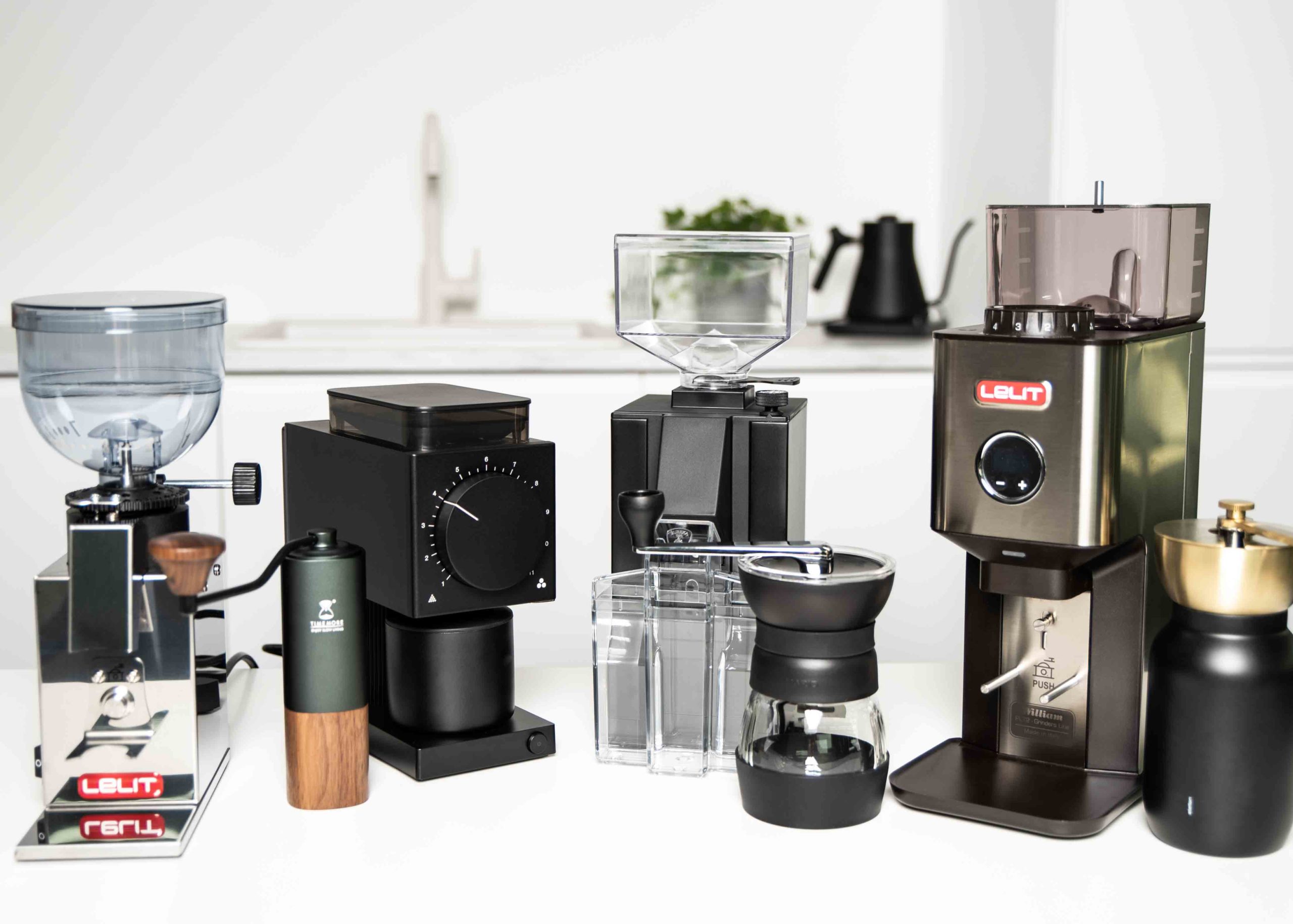
Let’s repeat what we’ve learned so far: the goal of grinding is to prepare coffee granules for coming into contact with water. We’ve also found out that the best flavours and aromas can only ever be extracted from freshly ground coffee beans — and that turns coffee grinders into truly indispensable tools. It’d be great if freshness was all that mattered here though… Instead, the quality of your grinder is just as important. You must consider if it grinds coffee consistently (this is where grinder type and burr quality come into play), if it matches your lifestyle (would a manual or an electric grinder work best for you?), if it’s capable of producing the grind required for your favourite brewing method, if it’s convenient to use and clean…
Don’t worry though: we’ll help you out by guiding you through the questions frequently asked by those who haven’t owned a coffee grinder before. We’ll also share some valuable advice on which aspects are crucial to consider and which ones are nothing more than insignificant details.
Blade Grinder vs Burr Grinder

The very first question you might encounter when choosing the right coffee grinder for you is this: burrs or blades? The answer is very straightforward: definitely burrs. Even though their compactness and price make blade grinders very popular, it might be more accurate to refer to them as “coffee crushers”. This is because these grinders simply crush beans, or chop them up, instead of grinding them. Moreover, these tools chop beans inconsistently, making one half of your coffee as fine as flour and leaving the other half reminiscent of table salt. Finer granules ultimately result in some unpleasant bitterness, while larger pieces make the drink more acidic than it’s supposed to be. What you’re left with is a poorly balanced flavour and a cup that seems to be covered in dirt once the coffee’s been consumed. So if you have a blade grinder at home, keep on using it for spices only — that’s exactly what it’s suited for.
On the other hand, if it comes down to choosing between pre-ground coffee and a blade grinder, the latter is the one to pick. This is simply due to freshness. If you want to unveil the best features of your coffee beans though, you should definitely listen to the experts and give a burr grinder a try. It’s not like burr grinders are that much more expensive: compared to blade grinders, their prices usually differ by no more than 50–60 pounds!
Burr grinders have two key advantages. First, their grind is more consistent — that’s already been determined. Secondly, they enable you to change the grind size. This is particularly important for those who have a couple of favourite brewing methods, be it preparing coffee in a cup, using a drip coffee maker or going after the illustrious espresso.
Manual Coffee Grinder vs Electric Coffee Grinder
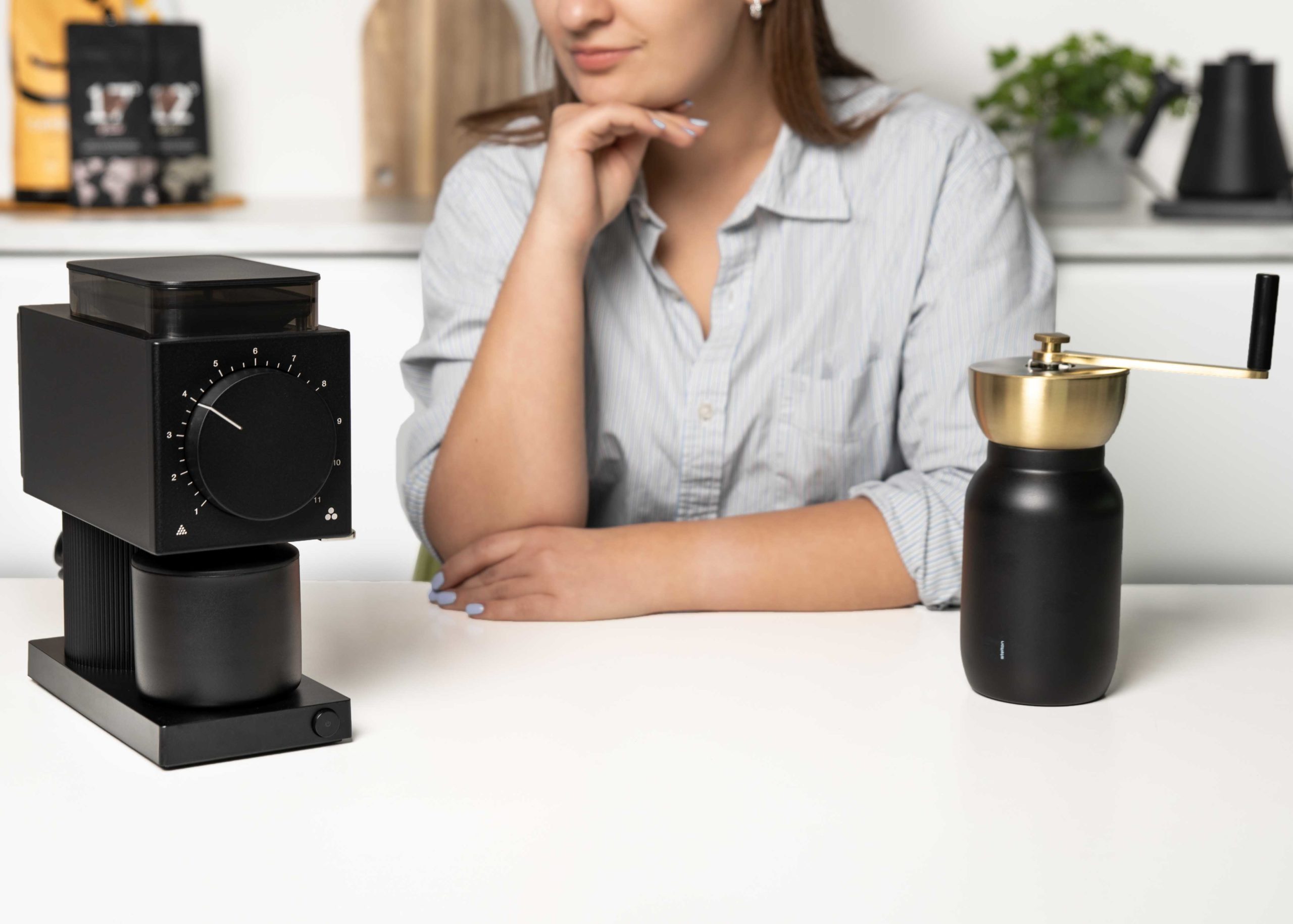
The second question you might want to have answered is whether a manual or an electric grinder is the better choice. The truth is, it all depends on your personal habits, needs and wants. To make choosing a bit easier, try and consider several aspects:
- Compactness, weight, mobility. A manual grinder is more compact, lightweight and mobile. If you tend to travel often and would like to take your grinder with you, go for a manual one and never look back! Electric coffee grinders are generally larger and heavier, so you won’t be able to throw one into your suitcase with such ease.
- Time, patience, effort. A manual grinder is the perfect choice if you plan on grinding small amounts of coffee and tend to go for a medium or coarser grind. However, if you consume lots of coffee every day, a manual grinder will require a great deal of patience, effort and time. To put it simply, you’ll have to really roll up your sleeves if you want to grind lots of coffee finely using a manual tool. An electric grinder makes it all a great deal simpler — it does the majority of the work for you. A grinder like that is hands-free and, as a result, it’s guaranteed to provide you with some extra free time. You should keep one thing in mind though: there are some people who need to put some real effort into whatever they’re doing to truly experience the pleasure that comes with creating something beautiful. If you’re one of them, a manual grinder is the right tool for you.
- Price. If you were to ask some grinder owners for advice, most of them would tell you that price is bound to play a part here. Good electric grinders are pricier than good manual ones, so if you’re on a budget, it might not take you that long to make your decision. Before you commit to buying a manual grinder, however, ask yourself once again if you’ll truly have enough time and patience to grind your coffee by hand every time you want to enjoy a cup.
- Noise level. Despite its importance, this aspect is often forgotten. If noise isn’t something you tolerate well in your house (because, for example, you have a small child), consider whether the sound of an electric grinder won’t be too much for you. A manual grinder is definitely the winner in this case: it grinds beans more quietly.
- Espresso and other brewing methods. Finally, if you can’t imagine your life without quality espresso, you should absolutely go for an electric grinder. Most manual grinders aren’t even capable of producing the grind required for proper espresso. Even if you do find a manual grinder that’s able to do that (it’ll definitely belong to the highest price range in that case), you’ll need to put a whole lot of effort into grinding the beans properly each time you feel like brewing a cup. As you know already, the finer the grind you’re going for, the more brute force is needed. And even that won’t guarantee a consistent grind… An electric grinder is much more convenient and better suited for brewing espresso: a quality tool of this kind will grind beans automatically, consistently and extremely quickly, producing a flawlessly fine grind that’s perfect for this brewing method.
All in all, when choosing a coffee grinder, consider your brewing habits and current circumstances. If you don’t like to limit yourself to a single choice, you can invest in both grinders (this is what true connoisseurs tend to do). An electric grinder will enable you to brew coffee at home with ease and enjoy your espresso quickly and conveniently, while a manual grinder will come in handy when you feel like making some drip coffee or taking your grinder with you on a trip.
Flat Burr Coffee Grinder vs Conical Burr Coffee Grinder

We’ve now come to the point of discussion that some well-known representatives of the coffee realm refer to admiringly as “esoteric”. Before we start digging into the details though, let us skip ahead a bit and assure you in advance that high-quality flat burr grinders and good conical burr grinders both work equally well. If you’re not interested in putting your coffee under a microscope or you can’t yet juggle numerous different tasting notes with ease when brewing your morning coffee, you won’t be able to tell the difference between beans ground using different burrs. However, if you’re feeling curious…
- Grind consistency. Flat burrs are made of two parallel, symmetrical shapes. Conical burrs, on the other hand, consist of a ring and a cone that fit each other perfectly. You wouldn’t be able to tell what kind of burrs were used to grind a portion of beans by simply looking at them — but if you were to place those beans under a microscope, it’d be clear as day. Flat burrs result in a more consistent grind and almost identical particles, while conical burrs produce granules of two different sizes: some of them are finer and others are a tad coarser (this is a feature of the so-called “bimodal grind”).
- Differences of flavour. Having read what was said previously, you might be tempted to instantly jump to a conclusion and proclaim that flat burrs are better — and this is where you’d be wrong. Instead of referring to an inconsistent grind, the “bimodal grind” of conical burrs describes a consistent grind of two different sizes. This ends up lending the coffee some extra intensity and a particularly pleasant texture. Some people say that this kind of grind is perfect for unveiling the rich flavour and splendid density associated with traditional espresso. However, sworn fans of flat burrs believe that coffee like that lacks the divine harmony, as well as “clarity” or “purity” of taste, that characterises the flavours found in the so-called modern espresso.
- Coffee retention. True coffee lovers value every single granule, so it should come as no surprise that they can often be caught complaining about the slightly larger amount of coffee retained by flat burrs. Because of the shape of these burrs, some coffee particles tend to get stuck inside them — and if you don’t clean your grinder often enough, such granules can have a negative impact on the flavour of the beans you’re going to grind next time. As far as coffee retention is concerned, conical burrs are a definite winner. They let fine particles fall freely, which means that there’s no way for them to get stuck inside the grinder. Over time, however, the manufacturers of high-quality coffee grinders have devised numerous creative ways to avoid this problem, so most modern flat burr grinders now keep coffee retention to a minimum.
- Noise level. Some people say that flat burrs are a tad louder than conical ones. Again, if you use quality grinders, you’re unlikely to notice any difference — unless, of course, you use a sound level meter!
- Price. Compared to conical burrs, flat ones may leave your wallet a little bit thinner — this is all due to their construction, which is a tad more complex.
Generally speaking, flat and conical burrs are only marked by subtle differences related to coffee retention (which is associated with freshness and the amount of wasted coffee) and flavour. As long as they’re high-quality, any burrs will work great. Well-known grinder manufacturers offer various burrs that can all be found within the same price range — this, again, confirms the fact that both burrs can serve their purpose equally well. As a result, you shouldn’t pay too much attention to this little aspect when choosing the right grinder for you.
Steel Burrs vs Ceramic Burrs
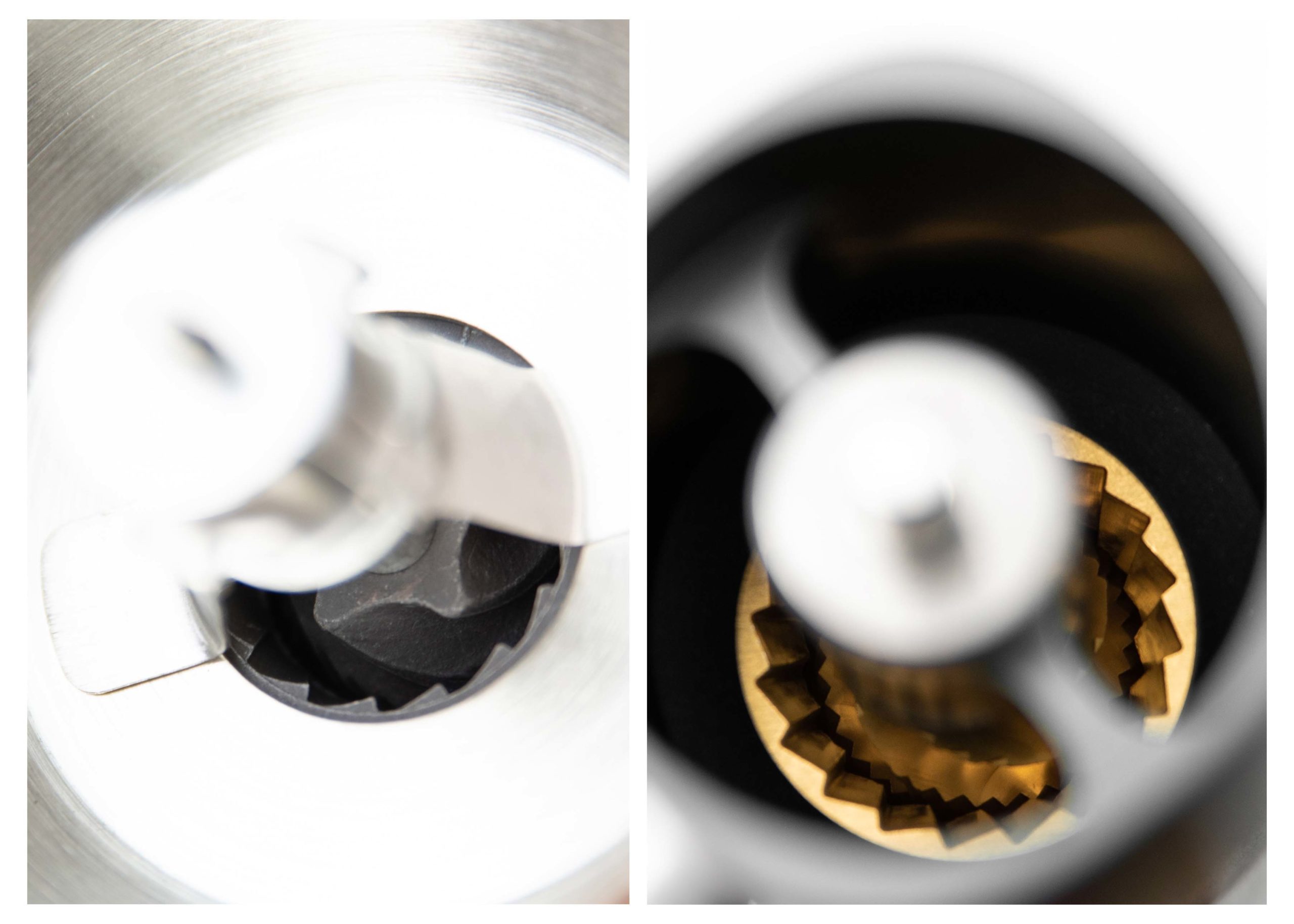
To go on with the “esoteric discussion”, we must consider another one of the eternal coffee questions: is it better to choose steel or ceramic burrs? As far as the flavour and quality of the resulting drink is concerned, again, there’s no right answer here — we can bet you wouldn’t be able to tell what kind of burrs were used to grind the beans by simply tasting a certain drink. However, there are a few aspects here that are worth considering. Let’s go through them together:
- Differences of flavour. Some experts claim that ceramic burrs end up producing more coffee dust, which affects the size and distribution of coffee particles. As a result, the drink becomes denser, its body is heavier, the flavours are sort of “masked” (similar to the taste produced by conical burrs). The grind of steel burrs is more consistent, while the flavour of the resulting coffee is “cleaner”, marked by distinct tasting notes. Because of this, it’s generally believed that ceramic burrs are better suited to traditional espresso and coffee bean blends, while steel burrs should be the preferred choice for those who love modern espresso, drip coffee and specialty coffee varieties.
- Hardness and brittleness. Ceramic burrs are harder than steel ones, so they tend to be around twice as durable. It’s not all that simple though: while ceramic burrs are definitely harder, they’re also more brittle. This means that if a stone happens to be hidden amongst your coffee beans, it can cause ceramic burrs to break quite easily. Steel burrs are less likely to be damaged in this case, but they still aren’t protected fully from various cracks or dents.
- Heat. During grinding, ceramic burrs don’t get as hot as steel burrs. However, this is only relevant when talking about intense commercial grinding and doesn’t make any difference at all if you plan on using your grinder at home or even in a small café.
- Noise level. Even though some people are convinced that ceramic burrs aren’t as loud as steel ones, this isn’t exactly true. What makes all the difference in this case isn’t the material the burrs are made of — instead, it’s their construction.
- Price. Compared to steel burrs of the same category, ceramic burrs tend to be cheaper.
All in all, as long as your grinder is high-quality, its burrs don’t make much difference: both steel and ceramic ones, flat and conical ones can do their job just as well. While other aspects discussed above may give you some food for thought, the choice is all yours in the end!
Tell Me How You Brew Your Coffee and I’ll Tell You What Kind of Grinder to Choose

If you’ve gotten the impression that choosing a coffee grinder is quite a difficult task, you’re not wrong: there’s definitely lots of grinders to choose from! However, as we’ve come to find out, the main point of reference here should be none other than your favourite coffee brewing method. You can go the easier route too and simply purchase a universal grinder, but this may not be the best solution if you’re a sworn fan of espresso.
First of all, this is because the espresso brewing method requires beans that have been ground extremely finely. Lots of universal coffee grinders aren’t even capable of doing that (it’s particularly true of the cheapest grinders on the market — even if you see the word espresso written on the grinder, it might not be able to produce the grind required for a cup of proper espresso).
Secondly, if you tend to employ different brewing methods from time to time, you’ll have to keep on adjusting the grinder and then readjusting it again once you’re keen on making some espresso. Trust us, it’s far from convenient and can get very tiring. It’s no surprise then that coffee connoisseurs often have two different grinders at home: they use one of them exclusively for espresso, while the other one is reserved for filter coffee. How do the two differ though and how can you choose the right one for you?
Coffee Grinder for the Espresso Brewing Method
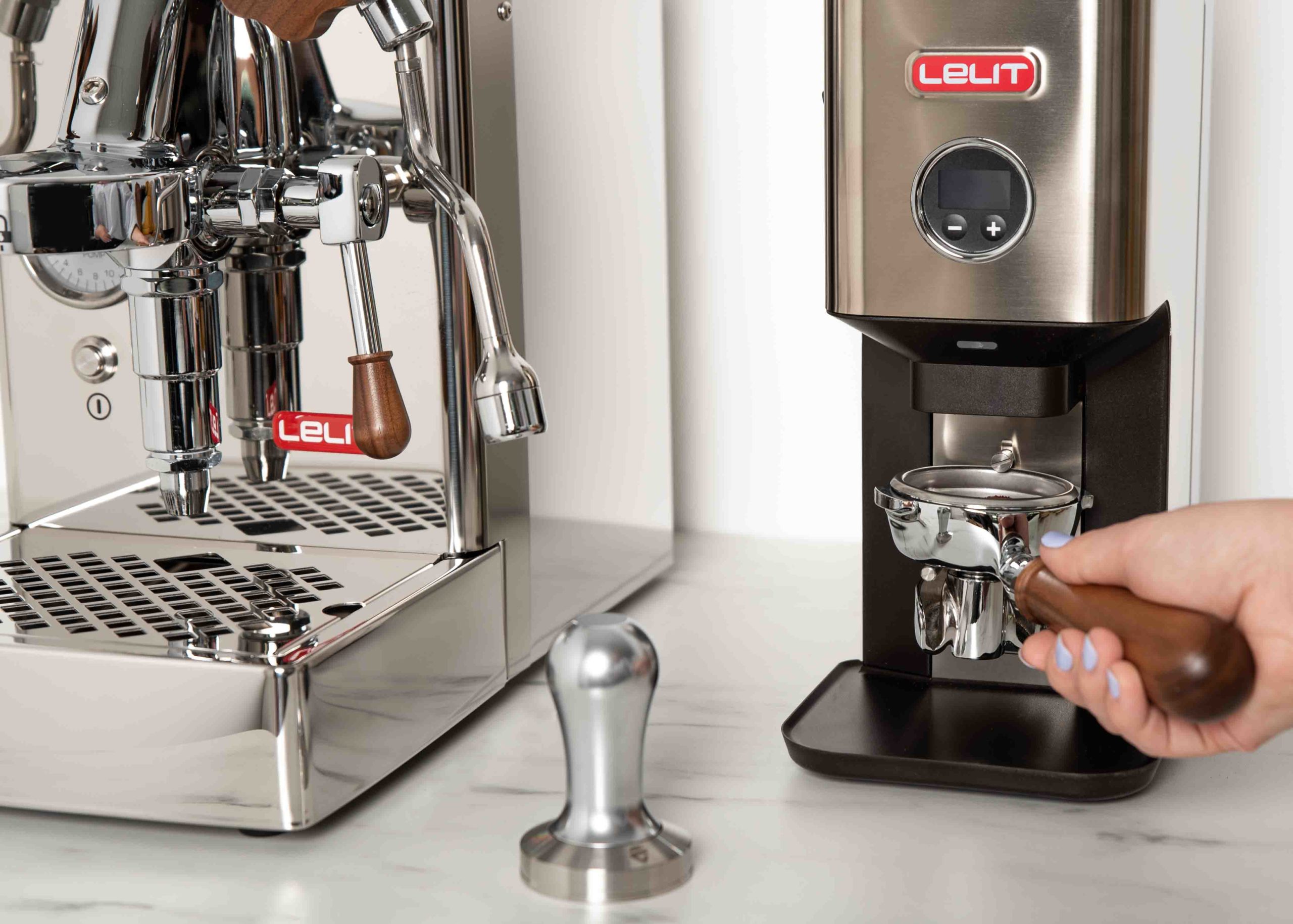
What kind of grinder is suitable for the illustrious espresso, you wonder? The answer is pretty straightforward: it’s the electric one. Electric grinders have been designed to produce the consistent and extra fine grind required by espresso. If you end up purchasing a grinder like this, it’d be best to use it for espresso only. Continuously adjusting and readjusting the grinder is both time-consuming and wasteful in terms of coffee. So, what should a true fan of espresso pay attention to when looking for the perfect grinder?
- Dosing system. Ideally, your grinder should grind each separate coffee portion straight into the portafilter. This is particularly important in this case because proper espresso can only ever be brewed using freshly ground beans, so they should reach the coffee machine pretty much as soon as they’ve been ground. A dosing system like that will prevent you from wasting some of the original aroma and flavour of your coffee.
- Engine power. Contrary to cheap coffee grinders, high-quality espresso grinders are equipped with powerful engines. The engines of most cheap models are quick and loud, but they lack the power necessary for producing finely ground coffee. This is why some people are in for an unpleasant surprise when they buy a cheap espresso grinder and are then disappointed by its fine-grinding abilities.
- Grind adjustment system. The espresso brewing method often calls for some micro-adjustments, so make sure that the grind adjustment system your grinder’s equipped with enables you to perform them. This system can be “stepped” or “stepless”. A stepped adjustment system is characterised by fixed steps and hence limits your freedom (it’s found more often in cheaper grinder models), while a stepless system lets you make the smallest adjustments with ease.
- Construction. To avoid half of your coffee being dumped next to the portafilter, make sure that the construction of your chosen grinder allows for “clean”, accurate dosing.
- Programming options (timer). A timer definitely comes in handy when you want to program an exact brewing duration and so ensure the uniformity of every serving of espresso.
- Ease and convenience of use. Ask yourself whether the grinder is easy and convenient to use: can you turn it on and off, adjust the grind size and program it with ease?
- Burr quality. What’s the difference between an espresso grinder that costs 100 pounds and one that costs as many as a few thousand? Well, for one, their finishes, design, engine power, ease of use, programming possibilities, grind adjustment options and the control you have over the grinding process as a whole are definitely going to be different. Most important though are the differences related to burr quality and grind consistency. According to coffee experts, this is where cheap and mid-priced grinders really diverge. A couple hundred pounds can make a world of difference. Coffee ground with the help of a high-quality grinder will be sweeter, “cleaner”, free of unpleasant bitterness or acidity. Its texture will be pleasant and it’ll leave a delicious aftertaste on your palate too.
Coffee Grinder for Filter Coffee or Brewing Straight in a Cup
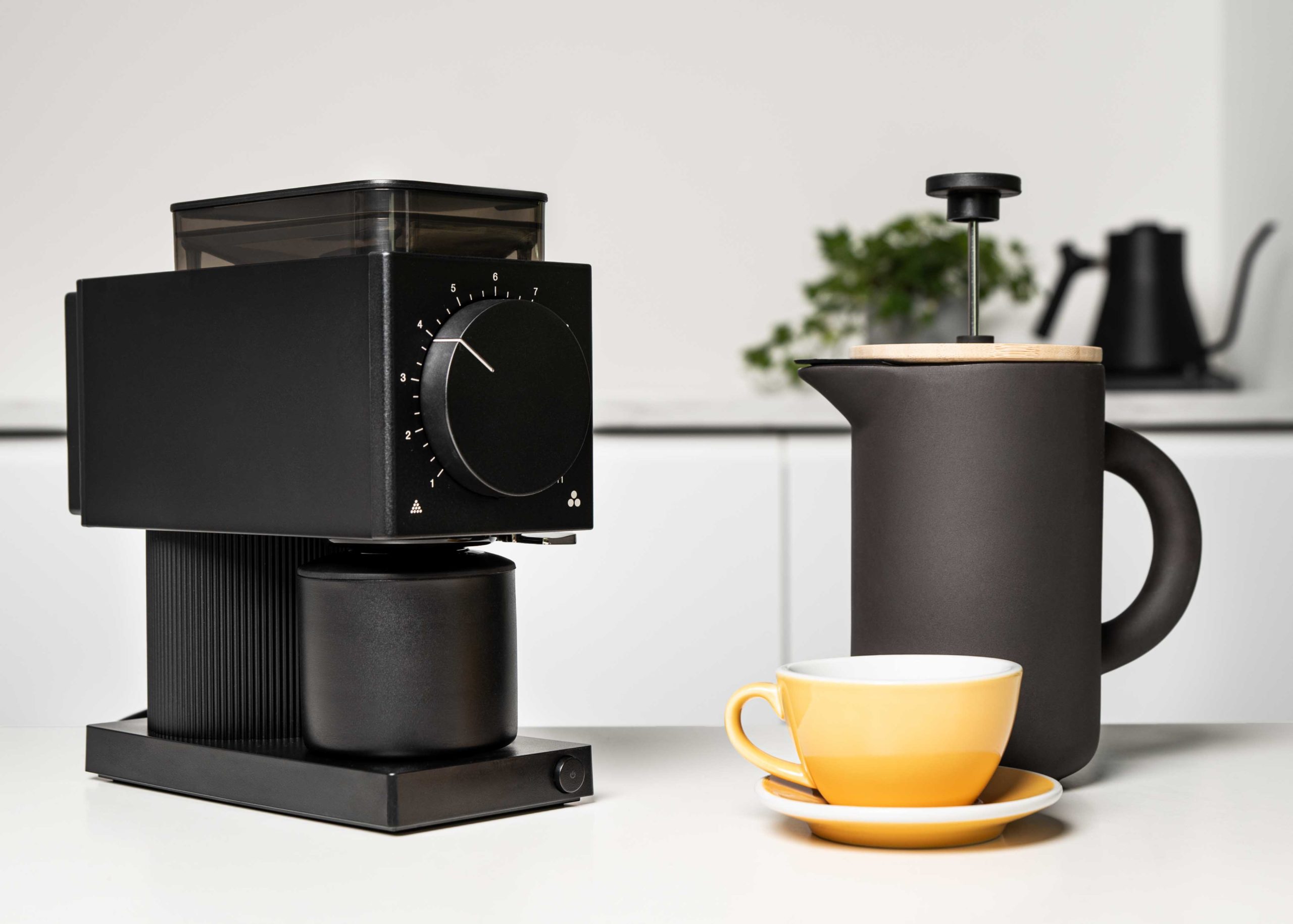
If you like drip coffee makers, fashionable filter brewing tools, French presses or the age-old tradition of brewing coffee straight in a cup, choose a grinder suited for these methods. The good news is that these grinders are typically cheaper than espresso ones — this is because they don’t require such powerful engines. So, what should you consider when choosing a grinder like that?
- Manual vs electric. We’ve already discussed this at length in a separate section, so all we’re going to do now is remind you about the importance of the type of grinder you end up choosing. If you’re interested in more details, read up on them above.
- Where do the ground beans end up? Grinders of this type are usually equipped with containers that the beans are ground into. If your chosen grinder has one, make sure you’ll be able to conveniently remove the ground coffee from the container for your favourite brewing method. You can also pick a grinder with a single-dose system: it’ll ground beans directly into a freestanding container. This is the best option, as it ensures maximum freshness.
- Convenient grind adjustment. Even though these brewing methods don’t require a grind that fine and micro-adjustments aren’t so crucial here, you should still consider the available grind adjustment options and make sure that the grind size can be conveniently changed when needed. This is particularly relevant when talking about manual grinders: some models might require you to disassemble the grinder almost completely in order for you to adjust the grind.
- Simple cleaning. Make sure that the construction and design of your chosen grinder allow for easy cleaning.
- Capacity. Make sure that your chosen grinder is capacious enough for you, especially if you’ve picked a manual grinding tool (they’re often equipped with small containers). Ideally, you should be able to grind enough coffee for the amount you plan on brewing at once.
- Construction and stability. The more stable the grinder remains during grinding, the more consistent its grind will be.
- Materials. Your grinder should be made of durable materials, be they plastic or metal. It’s just as important to make sure that the grinder is pleasant to touch — after all, you’ll be handling it every day.
- Burr quality. Flat and conical burrs, steel and ceramic ones have already been discussed, but what we mean here is burr quality itself, as well as grind consistency. Just like in the case of espresso grinders, high-quality burrs mean delicious coffee here too. It probably won’t surprise you to learn that quality correlates with price. However, it’s important to emphasise once again that a hundred pounds can make all the difference in this case.
Take Good Care of Your Grinder
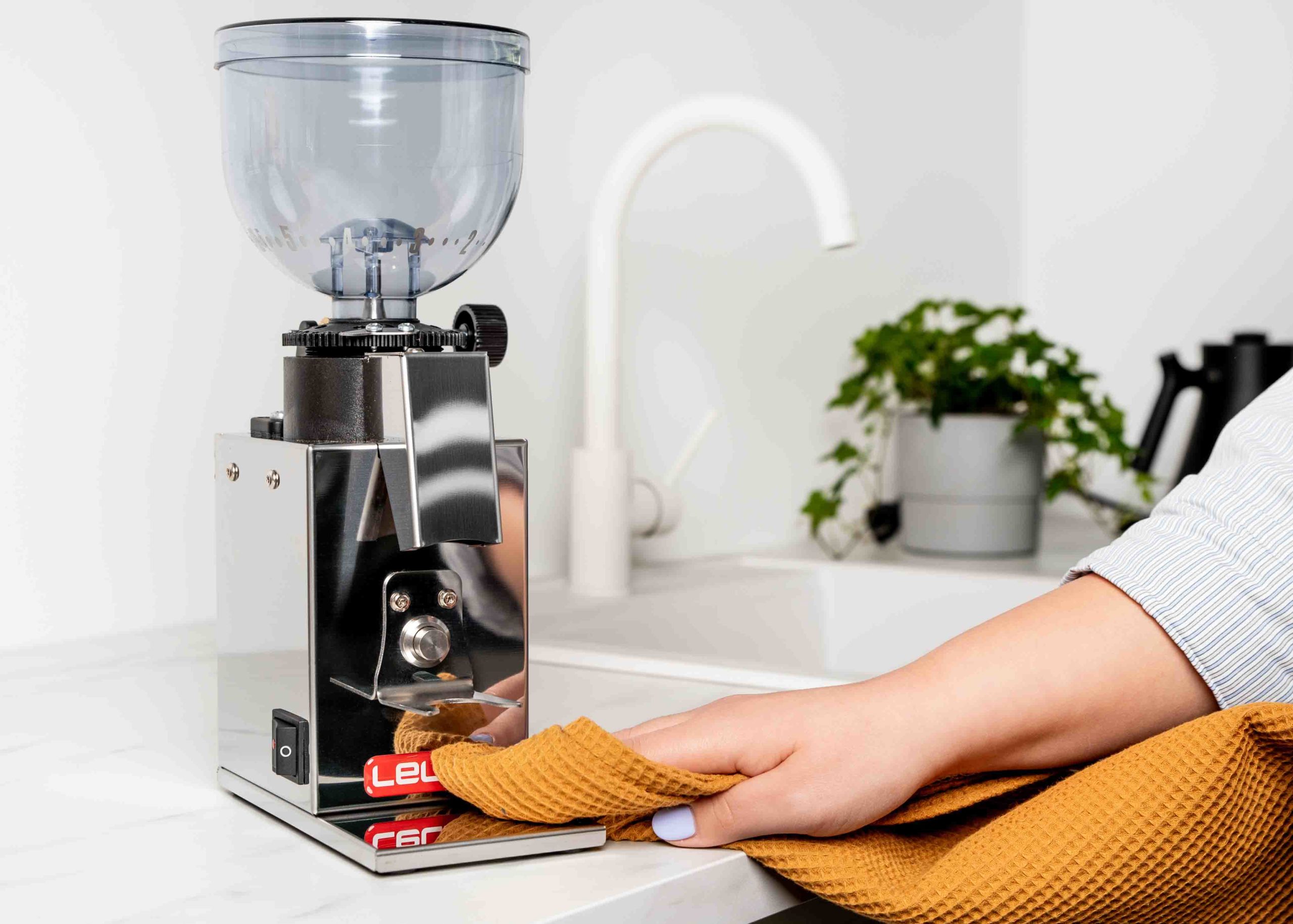
Once you’ve invested in a high-quality coffee grinder, invest some time in keeping it clean too. Remember: coffee is a food product. Following each new portion, you should clean the grinder, even if you don’t do that very thoroughly — otherwise, old coffee residues might end up ruining your next serving. There are natural oils found in coffee beans too: mixed with fine coffee particles, they can clog the burrs. Nowadays, you can even find special grinder cleaning tablets on the market, so maintaining your grinder is easier than ever.
Coffee Grind Chart: Grinding for Various Brewing Methods
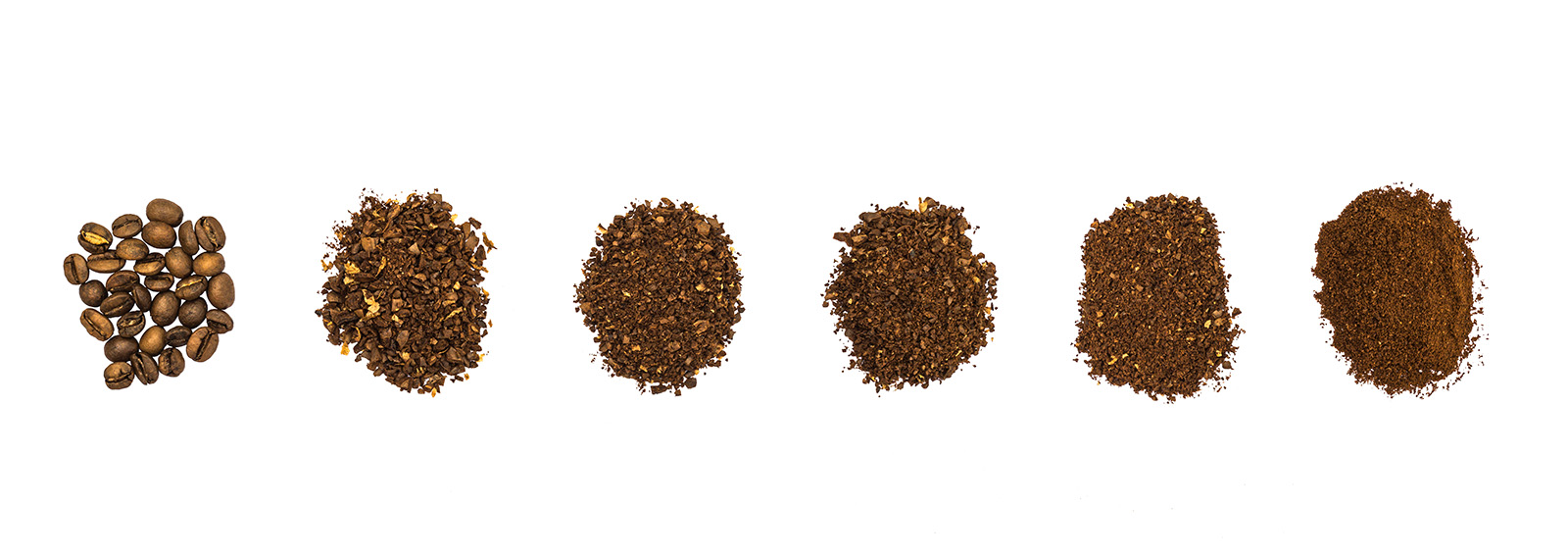
Different coffee brewing methods require different grind levels. There’s a rule of thumb though: if the coffee is too intense for you, grind it more coarsely. If, on the contrary, it isn’t intense enough, try grinding the beans more finely. It’s best to view such coffee grind charts as nothing more than recommendations or rough guidelines that can be used to jump-start your search for the flavour that’s perfect for you. If you were to observe barista championships year after year, it’d become abundantly clear to you that there are no universal solutions here. Coffee professionals keep on experimenting and trying out various grinds. As long as the flavours are balanced, their work can be considered done.
When it comes to different brewing methods, Coffee Friend recommends the following grind sizes:
Brewing coffee in a cup: coarse grind, similar to sea salt. When brewed straight in a cup, coffee stays in contact with water for a pretty long time, generally until it’s been consumed. A coarser grind slows down the extraction of flavours and ensures a lower caffeine content. If you grind your coffee finely and then keep it immersed in water for quite a long time, the flavour of the resulting drink might become unpleasant and the coffee itself might end up being too strong.
Moka pot: fine grind, similar to flour. If you want to make your coffee less bitter and avoid burning the beans during preparation, try a medium grind.
Turkish coffee pot: extra fine grind, similar to flour. This brewing method is one of the world’s oldest and only requires three things: a special coffee pot, water and beans that have been ground extra finely. The brewing duration is no longer than 2–3 minutes in this case, so by grinding your coffee finely, you’ll ensure maximum flavour extraction.
Espresso: finer than medium grind, similar to table salt. If water seeps through the coffee too quickly, it might mean that you’ve ground your beans too coarsely. Grind them more finely to slow this process down. Ideally, a portion of espresso should be brewed in around 20–30 seconds.
Bean-to-cup coffee machine: medium grind. Bean-to-cup machines are designed to make traditional coffee that most people like. The goal of these appliances is to brew drinks for just the right amount of time, which is why a perfectly medium grind will ensure optimal flavour extraction in this case. If the coffee turns out to be too acidic or bitter for your liking, choose a finer or coarser grind and adjust the flavour so that it matches your personal taste.
V60: medium grind, similar to sugar. If you find the coffee to be too acidic, this means that not enough flavour has been extracted, so grind the beans more finely and/or let them stay in contact with water for a bit longer. If, on the contrary, you find the coffee too bitter, weaken the extraction a bit by grinding the beans more coarsely and/or cutting their contact with water short.
French press: coarse grind, similar to sea salt. This brewing tool is characterised by a longer contact between coffee and water, so it’s important to avoid grinding the beans too finely. Different grinds can result in radically different flavours. The taste of coffee that’s been ground more finely might remind you of espresso, while a coarser grind will result in the traditional French press taste.
AeroPress: medium grind, similar to regular sand. This sort of grind is recommended when using the so-called “inverted” method. If you use the traditional one, grind your coffee finely. Just like in the case of the espresso brewing method, AeroPress utilises pressure, so you can give an espresso-like grind a try too.
Chemex: medium-coarse grind, similar to coarse sand or granules. If you grind your coffee too finely, the contact between coffee and water will last for too long. On the other hand, coffee that’s been ground too coarsely will result in water seeping through the beans too quickly, hence failing to absorb all of the soluble elements hidden in the coffee and not extracting enough taste.
Invest in Delicious Coffee by Buying a Quality Grinder
Coffee experts are right to refer to a new grinder as an investment. Some of them believe that a good coffee grinder is just as important as a high-quality brewing tool — if not more so. This is particularly true of espresso machines: while the machine itself is viewed as a crucial device, a coffee grinder is often disregarded. In fact, the latter deserves as much attention! If your coffee beans aren’t ground properly, no brewing equipment will be able to save them. So keep on striving for that elusive cup of perfect coffee!
Tips

- Freshly ground coffee is the tastiest and most fragrant, so if you’re still buying pre-ground coffee, you should definitely consider purchasing a grinder. Everybody deserves delicious, aromatic coffee — you included!
- Grind beans just before brewing and measure out an amount that’s needed for the servings you plan on brewing immediately.
- When choosing a grinder, consider its type: a burr grinder is better than a blade grinder.
- When choosing between a manual and an electric grinder, think about your lifestyle and brewing habits. A manual grinder will be easy to take with you on a trip. It’ll also be less noisy, but it’ll require more time and effort. Electric grinders are louder, but they’re faster and more convenient. If you’re a sworn fan of espresso, you’ll definitely need a high-quality electric grinder though.
- Remember that universal grinders aren’t, in fact, suited for all brewing methods. If you like both espresso and filter coffee, consider buying two separate grinders.
- When it comes to burrs, don’t overthink it. Whether they’re flat or conical, steel or ceramic, all of them do their job equally well as long as they’re high-quality. Some people may tell you that coffee ground with the help of certain burrs is tastier, but taste is always subjective.
- A consistent grind equals a well-balanced flavour. This is why buying a pricier grinder with better burrs is undoubtedly worth it.
- Don’t be afraid to experiment with various grind sizes. Your ultimate goal is a balanced flavour that’s neither too acidic nor exceedingly bitter.
- Take some time to maintain your grinder: clean it after each use.
- A good coffee grinder is a long-term investment. If you make the right choice, it’ll keep brightening your days for years to come!
